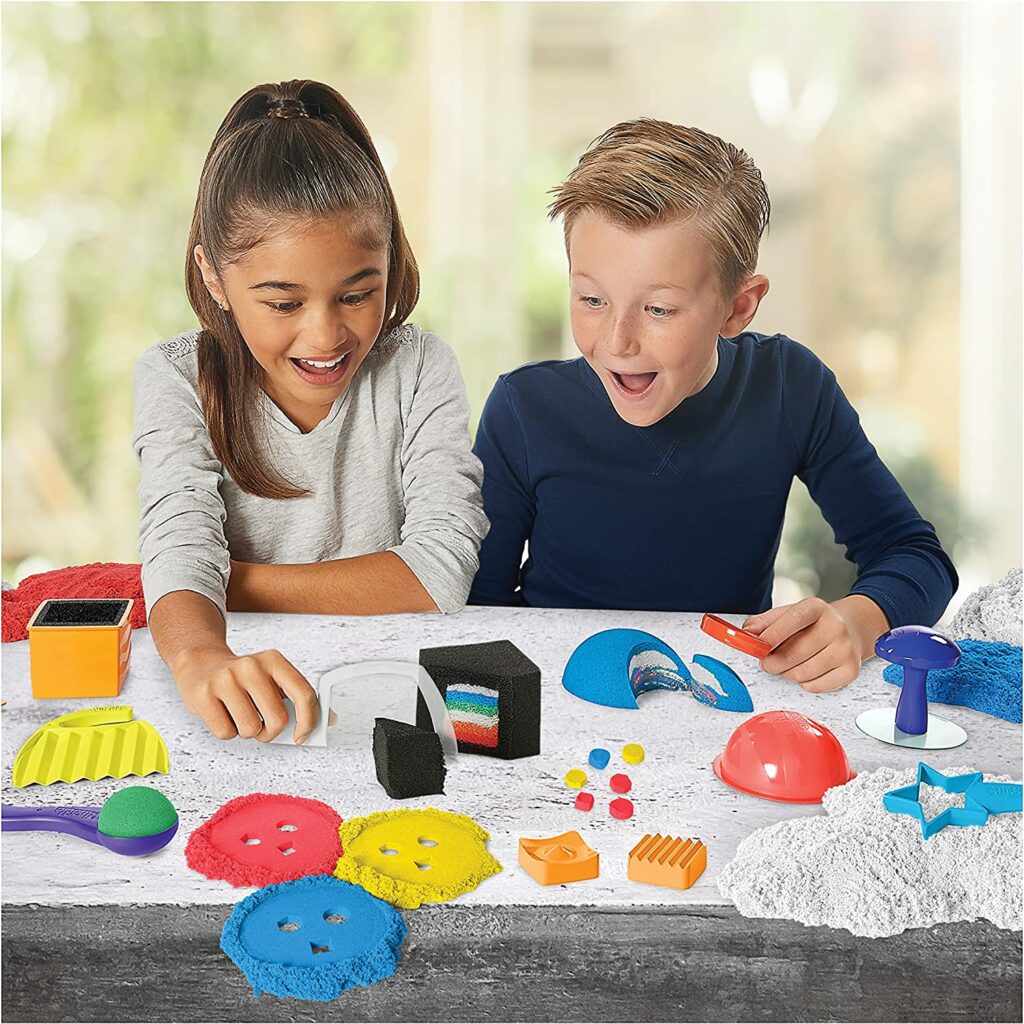Kinetic Sand Vs. Play-Doh: Which Is Better For Your Child?

If you’ve ever been to a toy store, you’ve probably seen Kinetic Sand and Play-Doh on the shelves. But what’s the difference between these two popular products? And more importantly, what is the best option for your child? Let’s explore this all in this kinetic sand vs. play-doh guide!
While both have the same play nature, are available in different colors, and can be made at home with a simple recipe, there are some important differences.
Kinetic sand is made from a special type of sand that doesn’t get sticky when it gets wet. This makes it a good option for kids who are sensitive to messes or tend to put things in their mouths.
On the other hand, Play-Doh is made from flour, water, and salt. It offers huge benefits in terms of affordability and ease of use.
Let’s take a look at both of these options one by one.
Table of Contents
What Is Kinetic Sand?
Kinetic sand is often called magic sand for being a type of sandbox play toy made from natural sand and polymer (silicone oil).
The sand is coated with the polymer, which makes it sticky and allows the sand to be easily molded into different shapes. Kinetic sand is also non-toxic and safe for children to play with.
What Is Play Dough?
Play dough is a type of modeling compound that is often used in arts and crafts. It is easy to make it at home with just a few simple ingredients, and it can be used to create a variety of shapes, figures, and objects.
Playdough is a great activity for children of all ages, and it has a number of benefits that can help to encourage creativity, fine motor skills, and problem-solving.
What are the benefits of play dough and kinetic sand?
Creativity
One of the main benefits of playdough and kinetic sand is that it encourages creativity.
There are no rules or limits when it comes to what can be created with play dough or kinetic sand, so children can let their imaginations run wild.
This creative play can help develop their creative thinking skills and allow them to express themselves in various ways.
Fine Motor Skills
This creative play can help develop their creative thinking skills and allow them to express themselves in various ways.
Fine Motor Skills
Another benefit of play dough and kinetic sand is that they can help to develop fine motor skills. This is because children have to use their little hands and fingers to mold and shape the dough into different forms. This can be a great way to improve hand-eye coordination and dexterity.
There are a few ways to work on fine motor skills to use play dough. One is to hide small objects inside the dough and see if your child can find them.
This is a great way to work on hand-eye coordination. Another way to work on fine motor skills is to have your child use small tools to cut, mold, or shape the dough and thus expand the range of fine motor skills your child applies during play.
Social Skills
Playdough and kinetic sand can also be a great way to work on social skills. This is because it can be used in a group setting in any age group. Toddlers can play with older kids and vice versa. Children can play with the dough and work on different projects together.
It is an excellent way to teach children ways to share, take turns, work together, and help them develop communication skills as well.
Language Skills
Play dough and kinetic sand can also be a great way to work on language skills. This is because children can use the dough to create different objects and shapes.
They can then describe what they have made. This is a great way to increase vocabulary and improve communication skills.
Another interesting read: Best Toys to Help Toddlers Talk – Development Speech
Problem-Solving Skills
Play dough and kinetic sand can also be a great way to work on problem-solving skills. This is because children often have to figure out how to make the dough into different shapes or objects.
This can be a great way to encourage critical thinking and problem-solving.
Sensory Play
Play dough and kinetic sand can stimulate the children’s senses and elevate their sensory awareness.
This fantastic sensory experience is essential for their development and can teach them to listen to their sensations while materializing their imagination in reality.
Independence and Self-Confidence
You can have a great afternoon with your kids making kinetic sand or playdough as they both can be made at home!
You can find a simple kinetic sand recipe and a homemade playdough recipe online.
After a quick search, you’ll discover that parents mostly search to make their own kinetic sand, whereas they prefer to buy play-doh at the store. I relate it to the fact that kinetic sand is relatively expensive, whereas you can easily purchase play-doh at a fair price.
Kinetic Sand Vs. Play-Doh
Kinetic sand and Play Doh are both popular children’s toys. They are both made of materials that can be easily molded into different shapes. So, which one is the best for your child?
In this section of the blog post, we will compare Kinetic sand and Play-Doh based on their features, benefits, and drawbacks. We will help you decide which one is the best for your child!
Below is a detailed description of the pros and cons of each type to help you make your choice easier.
| Kinetic Sand | Play Dough | |
| Suitable for children under 3 | No | No |
| Easy cleanup | Yes | No |
| No drying-out | Yes | No |
| Antimicrobial properties | Yes | Yes |
| Non-toxic | Yes | Yes |
| Inexpensive | No | Yes |
Pros of Kinetic Sand
Easy Cleanup
One of the best qualities of kinetic sand is that it’s so easy to clean up. Unlike regular sand, which can be difficult to get out of carpets and upholstery, kinetic sand is easily removed with a vacuum cleaner or damp cloth.
This makes it a great choice for homes with small children or pets, as there’s no need to worry about accidental messes. In addition, kinetic sand is also hypoallergenic, so it’s safe for even the most sensitive skin.
As a result, cleanup is quick and easy, and there’s no need to worry about harmful chemicals or allergens.
No Drying-Out
Another great thing about kinetic sand is that it never dries out. That means no more dealing with the hassle of storing wet sand or having to add water every time you want to play.
And if you accidentally leave your kinetic sand out, it won’t harden into an unusable lump. All you need to do is give it a little stir, and it will be good as new. This is a definite perk for both kids and adults who like to play with sand but don’t want the mess that comes with it.
Read also:
Antimicrobial Properties
Kinetic sand is a type of sand that is said to have several benefits over regular play sand. One of those benefits is that it is antimicrobial, meaning it helps to prevent the growth of bacteria and other microbes.
This can be especially beneficial for young children, who often put their hands in their mouths after playing with sand.
In addition, kinetic sand is also said to be non-toxic and hypoallergenic, making it a safer choice for those with relatively sensitive skin or allergies. While it may be more expensive than traditional sand, its unique properties may make it worth the investment.
Cons of Kinetic Sand
- Not suitable for children under 3
- Relatively expensive
Pros of Play Dough
Relatively Inexpensive
Play-doh is inexpensive compared to kinetic sand but also considered objectively affordable.
It’s no secret that children can be expensive. Between the cost of food, clothes, and education, many families find it challenging to make ends meet.
One such way is to purchase relatively inexpensive toys, such as playdough. Although playdough is not the most luxurious toy on the market, it provides hours of fun for children of all ages. Therefore, it is an excellent choice for busy families who are looking to save money.
Non-Toxic
One of the great things about play dough is that it’s non-toxic. Unlike some other arts and crafts supplies, you don’t have to worry about your younger kids ingesting playdough or getting it in their eyes.
And if they do happen to get it in their mouths, it’s not going to hurt them. Additionally, Play Dough is also safe for use around pets. So if your child accidentally drops some on the floor, you don’t have to worry about your cat or dog licking it up and getting sick. All in all, Play Dough is safe and non-toxic.
Another interesting read: Best Wooden Play Dough Tools – Playdough Toys
Cons of Play Dough
- Unlike kinetic sand, it leaves residue on hands.
- Cleanup is difficult
- Quickly dries out
- Not suitable for children under 3
Conclusion
In the end, it really comes down to personal preference. If you’re unsure which one to choose, we recommend trying both and seeing which your child prefers. Whichever one you choose, your child is sure to have hours of fun!
Read also:
- Best Wooden Play Dough Tools – Playdough Toys
- What Happens if You eat Kinetic Sand?
- Is Kinetic Sand Toxic?
- Can Kinetic Sand Get Wet?
- Does Kinetic Sand Dry Out?
- Is Kinetic Sand Biodegradable?
- Why Is My Kinetic Sand Sticking To My Hands?
- Is Kinetic Sand Magnetic?
- The Importance of Role Play In Child Development
